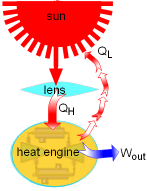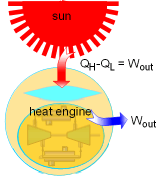| Ch 5. Second Law of Thermodynamics | Multimedia Engineering Thermodynamics | ||||||
| Heat Engine |
The Second Law |
Carnot Cycle |
Carnot Heat Engine |
Carnot Refrigerator |
|||
| The Second Law | Case Intro | Theory | Case Solution |
| Chapter |
| 1. Basics |
| 2. Pure Substances |
| 3. First Law |
| 4. Energy Analysis |
| 5. Second Law |
| 6. Entropy |
| 7. Exergy Analysis |
| 8. Gas Power Cyc |
| 9. Brayton Cycle |
| 10. Rankine Cycle |
| Appendix |
| Basic Math |
| Units |
| Thermo Tables |
| eBooks |
| Dynamics |
| Fluids |
| Math |
| Mechanics |
| Statics |
| Thermodynamics |
| ©Kurt Gramoll |
|
|
||
|
Determine how hot the focal point of a magnifying lens can be. |
||
|
|
Assuming that the focused sun beam can reach a temperature higher than the temperature of the sun itself. A machine can be designed like this: A focusing sunlight system is used to focus sunlight. The assumption gives that the beam can reach a higher temperature than the sun. Hence, the sun with the focusing system can be used as a heat source and the sun itself can be used as a heat sink. A heat engine receives heat (QH) from the heat source, outputs work (Wout) and rejects the waste heat (QL) to the sun. The heat engine needs to satisfy the first law first. That is, QH = QL + Wout The combined system of the lens and the heat engine gives a new heat engine. In this design, the sun is the heat source and also the heat sink. The sun gives heat QH and has QL back. The net heat transfer to the new heat engine from the sun is: QH - QL = (QL + Wout) - QL = Wout Hence, the new heat engine works like this: It receives heat from the sun only and convert it totally to work. This design violates the Kelvin-Planck statement of the second law and the new heat engine is a perpetual-motion machine of the second kind. It means the assumption that the focused sun beam could become hotter than the sun itself is obviously wrong. This case gives an idea that a focusing system can not produce a temperature higher than the source itself. |
|

